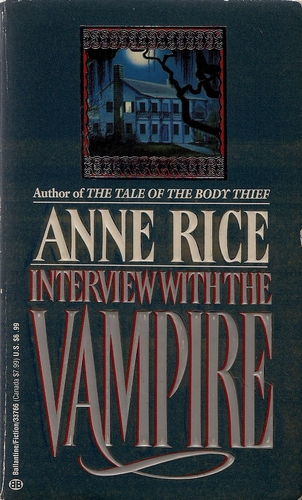By their very nature vampires seems
destined for isolation. Though they share many superficial similarities with
humans they are parasites by nature, isolated in what what Rice refers to as a ‘forest
of humanity’. In Interview with the Vampire Rice explores one such vampire,
who struggles to balance his baser instincts with his need for companionship on
his immortal journey. The through line of the story is the relationship between
Louis and the cruel and guileful Vampire Lestat. Although Lestat constantly toys
with Louis, torments him even, the reality is Lestat is the true benefactor from
their relationship. He is desperate for companionship and his monstrous
behavior is partly his true nature and partly a smokescreen to
hide his weakness. Louis for his part accepts his cohort in immortality. At
first out of necessity and fear as he grasps for anything after the death of
his brother, but later it seems out of a begrudging fondness for Lestat. But immortality
it would seem is destined to devastate any relationship.
Tormented by a nagging sense of morality Louis does everything in his
power to resist Lestat’s constant invitation to succumb to his baser urges.
Slowly Louis caves to Lestat and his own craving for human nourishment. Louis
becomes disillusioned with Lestat’s glaring lack of humanity and his own
bloodlust. As Louis contemplates leaving, Lestat introduces him to the most
important relation of all, the little vampire girl Claudia. They take her in as
their ‘daughter’ so they may stay together to care for her. Although Louis and
Lestat take up pseudo-parental roles, it would be inaccurate to characterize
their relationship as father-daughter. Lestat plays the role of the stern,
father figure who teachers her the violent facts of vampire life and Louis is
more mothering and teaches her the joys of knowledge and critical thinking.
Even so, for all Louis’s endless adoration, Claudia is still more of his
plaything, his docile vessel to fill with ideas. Since it is not a parental or
sexual relationship the only explanation for Louis’s attachment to Claudia is
his feeling of power over her as well as the connection to what her innocent
form represents in his last vestiges of humanity. What Claudia gets from their
relationship is not immediately clear obvious, however it is
very different from what Louis is receiving. It is only when Claudia starts to
use some of the knowledge she gained from Louis to uncover the
truth that their relationship starts to break down. From that point on they
are only ‘bound together by hatred’ as Claudia says. When it is clear that
Claudia has turned monstrous and the power dynamic shifts again Louis feels
lost. It is this shifting of power that
turns Louis and Claudia against Lestat and leads Louis briefly towards Armand, a
turn of events that spells ruin for all. After so much loss, Louis takes the
only reasonable approach and becomes a solitary creature. The path that seems
destined for all vampires that, like Louis still retain some inner spark of humanity.

